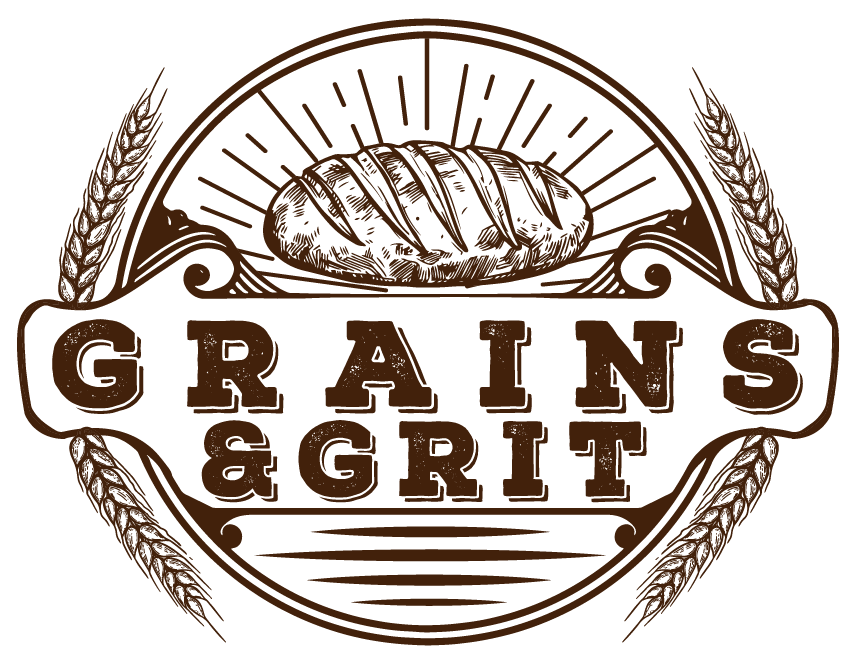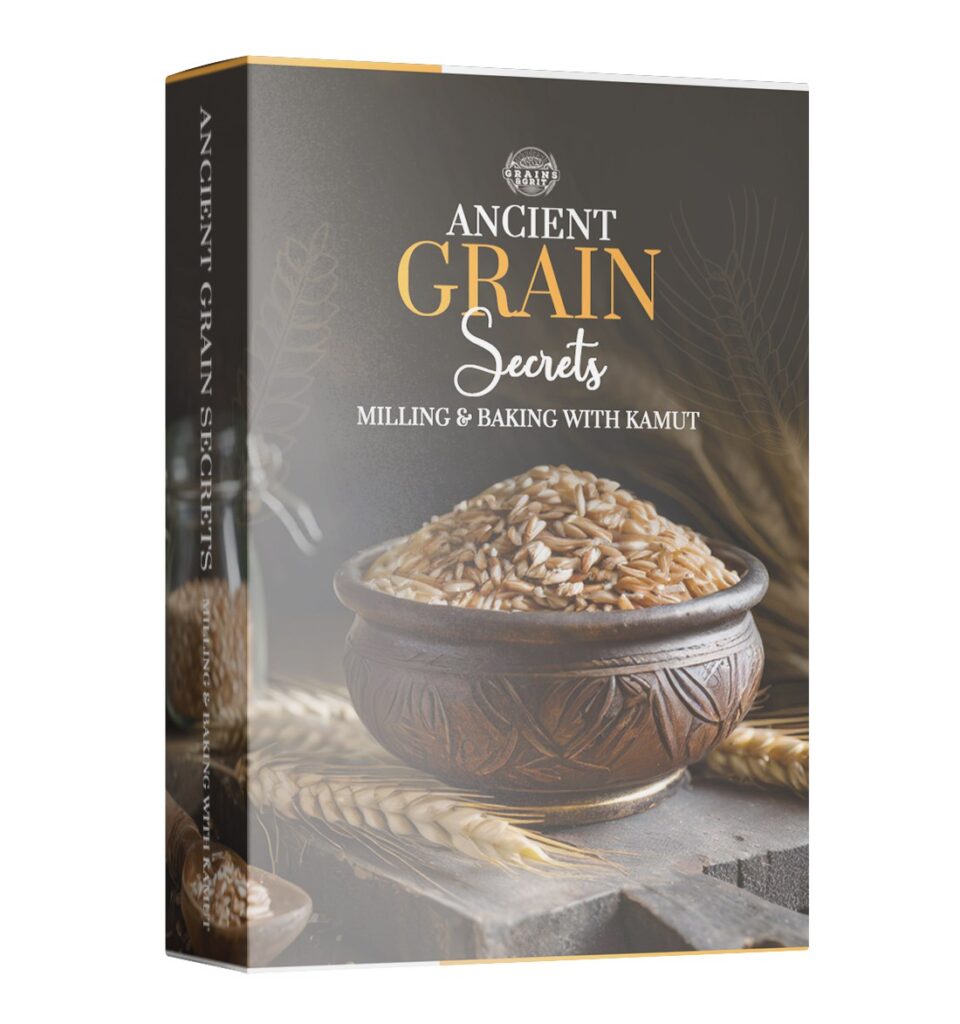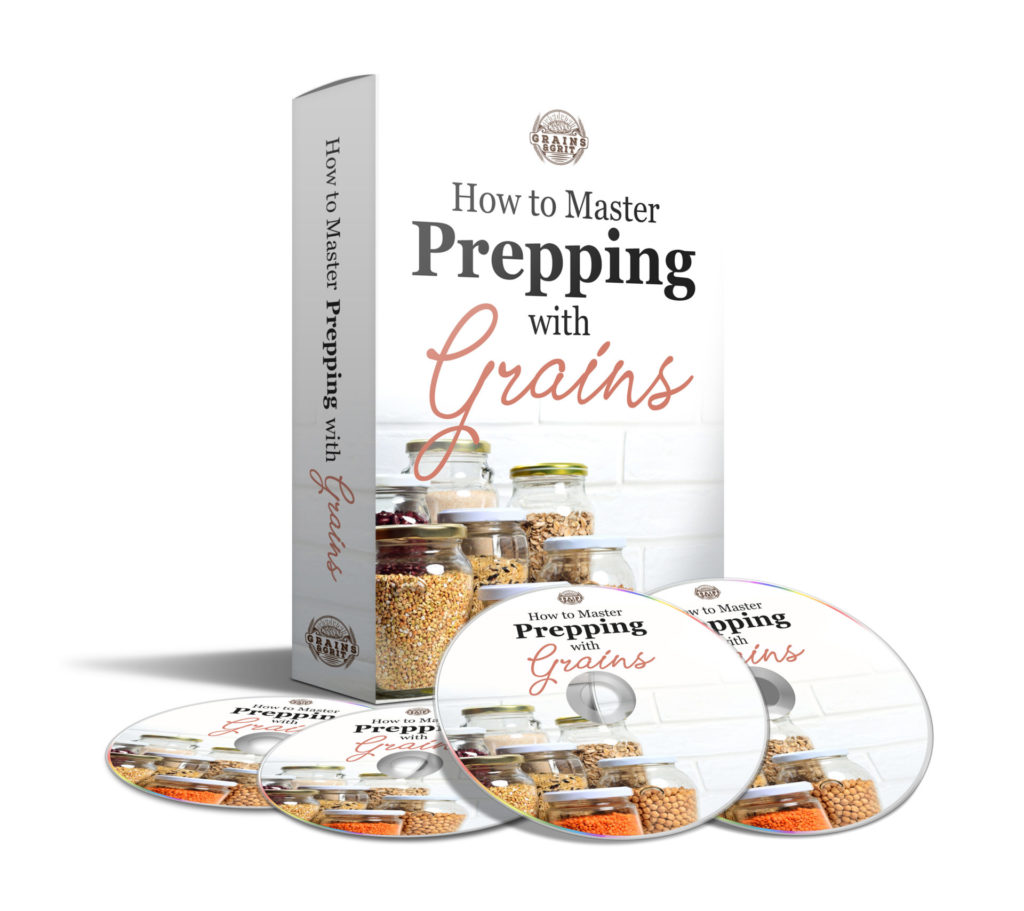This is September’s bread for our #makebread365 challenge for 2023! To check out the entire 2023 challenge go to www.grainsandgrit.com/makebread365
When trying to make ciabatta bread with 100% freshly milled wheat it was certainly a challenge! I never found a recipe anywhere that gave the results I wanted AND didn’t use any bit of store-bought flour.
Ciabatta is an Italian shorter loaf-type bread that looks like a slipper – hence the name! It was created by Italian bakers in response to the popular French baguette.
Ciabatta is known of a large open crumb, which CAN be achieved with the right technique using nothing but 100% freshly milled wheat!
This may take a few tries to achieve, but practice will make your loaves better so don’t give up if the first attempt fails! The technique MATTERS in this recipe!
Enjoy!

Ciabatta Bread with 100% Freshly Milled Wheat
Ingredients
Biga
- 1 cup warm water
- 1/4 tsp instant yeast
- 1 1/2 cups freshly milled hard white wheat flour, milled fine mill 1 cup of hard white wheat berries
Autolyse
- 3/4 cup warm water
- 2 cups freshly milled hard white wheat flour, milled fine mill 2 cups of hard white wheat berries
Final Dough Mix
- 3 TB warm water
- 2 tsp instant yeast
- 1 3/4 tsp salt can increase to 2 tsp to taste
- all of the biga mixed earlier
Instructions
The Biga
- Combine 1 cup warm water, 1/4 tsp instant yeast, and 1 1/2 cup freshly milled hard white wheat flour into a jar or bowl. Mix well. Make sure there are NO dried clumps of flour left.
- Cover loosely with a towel, lid of jar, etc and ferment at room temperature for 6-24 hours. If you need it to go beyond 24 hours, place in fridge. The longer this ferments, the stronger the flavor will be. See notes below.
Autolyse
- When the biga is ready, combine 2 cups of freshly milled hard white wheat flour and 3/4 cup warm water into a mixer or bowl. Using your dough hook, mix well until all flour is incorporated. The dough will look shaggy, slightly moist, and a lumpy (see video for details). Cover with towel or cover of mixer and rest for 30 minutes.
Final Dough Mix
- To the autolyse, add 3 TB warm water, 2 tsp instant yeast, 1 3/4 tsp salt, and all of the biga.
- Mix together on a medium low speed (speed 1 for Bosch Universal Mixer Plus; speed 2-3 for Nutrimill Artiste) for 3 minutes
- After 3 minutes, scrap down sides of bowl if needed. Then mix on medium high speed (speed 2-3 for Bosch, 4-5 for Nutrimill Artiste) for 5 minutes. Dough will be moist.
- After kneading for 5 minutes, dough should be stretchy but sticky. If dough is falling apart, knead a bit more until it's shiny, smooth, and stretchy but sticky (see video for details). Remove dough and place in a greased bowl. Cover with plastic wrap and rise for 30 minutes.
- After 30 minutes, do a stretch and fold (see video). Cover again with plastic wrap and rest again for another 30 minutes at room temperature.
- After resting, lightly spray counter with some water and place dough onto wet surface. Gently spread dough out to a large rectangle. On the long end, fold over 2/3 of dough, then the remaining 1/3 of dough over that. Like folding a letter to stuff in an envelope (see video). This is called lamination. Roll up dough as seen in video (not super tight) and place back in greased bowl for another 1 hour up to 1.5 hours.
- When dough has risen, be VERY gently when handling it from this point on!
- Liberally flour your work surface. Prepare a large piece of parchment paper and liberally flour that surface.
- Gently release dough from bowl onto floured surface. GENTLY pat into a square slab. If you press too much you're degassing those wonderful bubbles that have formed on the inside of the dough.
- Cut dough into two equal rectangles. Gently transfer to parchment paper.
- Cover and proof at room temp for about 30 minutes. Dough is proofed when you carefully push on dough with finger and it gently comes back.
- While dough is proofing, prepare your oven. Preheat oven to 500 degrees F.
- Place on lower third of oven a baking steel, stone, cast iron griddle, etc. On the bottom of stove place another cast iron or some sort of baking dish that can handle high temps and boiling water being put in. Prepare a roasting cover of some sort (see video for details).
- Boil about 2-3 cups of water.
- When oven is preheated, and the dough has been proofed. Carefully slide dough onto your baking steel in oven with the parchment paper. Cover with your roaster cover.
- Add boiling water to the pan at the bottom of the oven (if your oven door has a glass cover, you may want to cover with a towel while pouring the water to prevent glass from cracking. Remove towel before closing oven door).
- Quickly close oven door and bake for 12 minutes.
- After 12 minutes, remove roasting pan cover. Decrease heat to 480 degrees and bake for 13-15 more minutes until crust is browned.
- After baking, remove and place on cooling rack. Allow to cool for at least 40 minutes.
- Slice open and enjoy!!!
Notes
In my experience, hard white wheat is best. I have not experimented with other wheats! For steaming affect in oven
If you do not have a roasting cover like in video to steam the bread, the crust just may not be as crusty. The bottom of a disposable turkey roaster works great as an inexpensive cover to create steam affect. You can use a Dutch oven instead if it will fit the bread! Storing Bread
When bread is cooled, it can be stored in an airtight container or bag for about 2-3 days.




I know this is for ciabatta bread, I just want to say “thank you,” I’ve been looking for a true sourdough loaf of bread that’s SOFT AND DELICIOUS with a nice crumb.
I know you haven’t really jumped into the sourdough ring much according to your videos.
I am fairly new to sourdough and have been struggling to find a soft and delicious and a great crumb. Mine have been very dense UNTIL YOUR Ciabatta recipe.
I took this recipe and modified it to create my soft sourdough bread loaf. Instead of using the Vega, I used 100g of sourdough starter, 200g hard white freshly milled flour, 200g warm filtered water.
Mixed and sit for 4-6 hours or until doubled.
MIX 2 C hard white wheat flour
3/4 C warm water and salt (dissolve in water)
All sour dough starter and mix form3 minutes and rest for 30 minutes.
Then mix for 5 minutes, then put in an oiled bowl and cover let rest for 30 minutes.
Do your stretch and folds, and rest for another 30 minutes.
Put on a moist counter and do the rectangle folds and roll.
AT THIS TIME, I roll in some flour to prevent sticking. I then SHAPE THE DOUGH INTO A SEMI TIGHT RECTANGLE then I put it on a silicone floured mat and put it in my 2# loaf pan and let rise in my oven “under proofing setting” in my oven. Takes a few hours to rise just above sids of pan. Sour dough doesn’t seem to rise for me much while baking.
Once it gets to this point, I leave bread loaf in the oven while I preheat the oven to 350 degrees, put some water in a water proof container, bake covered with aluminum foil for 20 minutes then remove foil and bake until the inside of dough reaches 190 degrees. Once it reaches 190 degrees, I take it out and leave in pan for 10 minutes, then remove loaf from pan and put on a cooling rack and let cool. Oh my gosh. It is so delicious and soft. Thank you again for the recipe.
Thank you so much, Vanessa, for posting your sourdough version in detail. I’d love it if you added a photo to your post if that’s possible here!
Are you still making it now, 2 years later? Can’t wait to try what you did, after I try the FMF Ciabatta.
Biga
1 cup warm water
1/4 tsp instant yeast
1 1/2 cups freshly milled hard white wheat flour, milled fine mill 1 cup of hard white wheat berries
Autolyse
3/4 cup warm water
2 cups freshly milled hard white wheat flour, milled fine mill 2 cups of hard white wheat berries
appears autolyze has 2 c. berries = —> 2 c. flour ??
“appears autolyze has 2 c. berries = —> 2 c. flour ??”
Weigh your ingredients. 200g wheat berries will produce 200g flour.
Converting volume recipes to metric weights isn’t hard, but it is tedious. KABC has an Ingredient Weight Chart with hundreds of common items with volume and metric equivalents. What isn’t shown there, one can easily discover at home, using an inexpensive scale. Once you go Metric, you will never look back! And all of your baked goods will be *reproducible*.
I do not weigh my ingredients solely because when using freshly milled flour, the amount can vary each day based on weather, what type of wheat was used, etc. That’s why I don’t weigh, I just understand the result I am looking for. People can weigh all-purpose flour because it’s the same no matter where you live. Not the same with freshly milled which makes it so exciting!
Is it 2 cups if flour ir 1 cups of wheat berries?
Is it 2 cups of flour or 2 cups of wheat berries?
I have an emile henry ciabatta baker. when you let it rest on the parchment and rise would I lay it in the baker? and do I still need to use the boiling water in the bottom of the oven?
I have no idea. I am not familiar with this baker.
Can I use regular dry yeast instead of instant? Thank you
Yes, it just may take longer to rise!
Is it okay to add the salt on top of the yeast?
Salt and yeast typically do not like each other. It’s why we usually separate them when it comes to baking.
Great recipe and your video made it easy to follow.
I used a combo of both red and white wheat and it was fine. I regularly switch between them or combine them and really think they are virtually interchangeable.
Will echo the sentiment about weighing ingredients. I only weigh in metric and find it gives the most consistent results. We have uniform temp and humidity in the house as we live in South Louisiana where we normally use A/C all year.
I also cook to temp for the same reason. The bread comes out at 95 C (200 F).
Thank you for all the good content!
2 cups freshly milled hard white wheat flour, milled fine mill 2 cups of hard white wheat berries
What a mystery! 2 cups of hard white wheat berries produces over 3 cups of freshly milled flour which is way more than the 2 cups freshly milled flour you specify!
I am so reluctant to use all this flour! But yet, your video says use 3 cups wheat berries!
I am in a quandary–go by your cups of wheat berries or your cups of freshly milled flour!
I do respectfully disagree with your comment below about the flour quantity variation created in different climates. Your recipe is not showing consistency in the amount of flour generated from the wheat berries: in the Biga you state 1 cup of berries generates 1.5 cups flour. Yet for the Autolyse you state 2 cups berries generates 2 cups flour! Which measurement should we trust in this recipe?
Your video says to use 3 cups of berries. Maybe this is the measure you want us to go by and not your cups of flour, which are inconsistent results Biga vs Autolyse.
Ok–I’m headed I to make the Autolyse–in a quandry for sure: Do I use your measure for cups of wheat berries? or for cups of flour?
I followed the directions exactly and part of my ciabatta even though it was covered was burnt. It failed to rise. I feel this recipe needs some improvement measurements etc.
I wish KA mixer had been included in the instructions.My dough is VERY wet. Hard to form into a roll after fold, will see how it ends up but right now I’m not optimistic
Update: As I predicted they did not turn out. Never really reached a dough ball consistency. No rise on the “shaped” loaves. And bake is pretty much flat. Wish I could share pics. All day work for not. I’ve had failures before but this one was pretty epic. Glad to hear it has worked for orhers.
Can I use Active Dry yeast instead of instant?